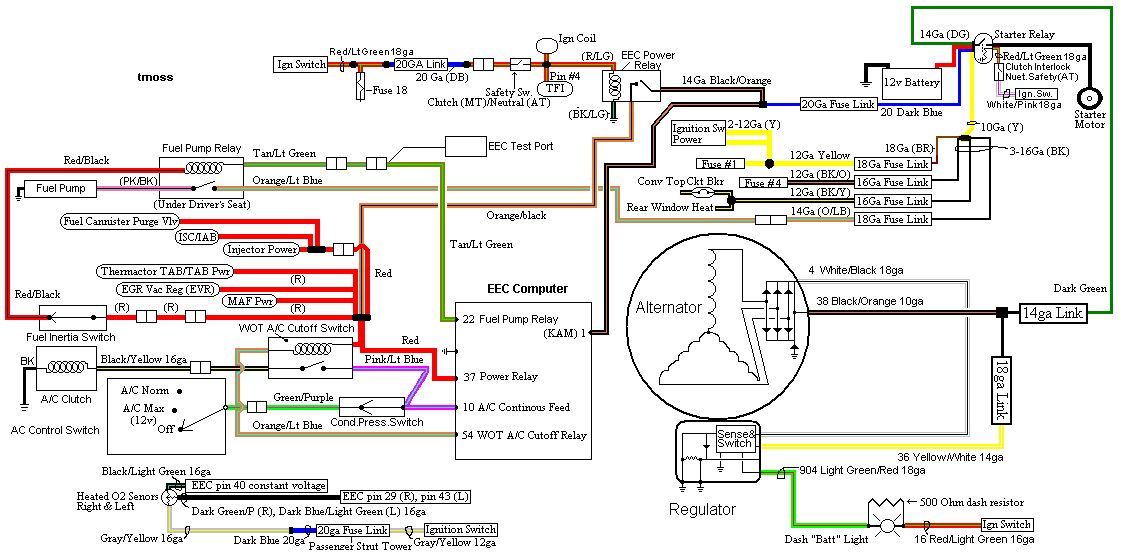Rear mounted battery ground wiring. Follow this plan and
you will have
zero ground problems.
One 1 gauge or 1/0 gauge wire from battery negative post
to a clean shiny spot on the chassis near the battery. Use
a 5/16” bolt and bolt it down to make the rear ground.
Use a 1 gauge or 1/0 gauge wire from the rear ground
bolt to a clean shiny spot on the block.
One 4 gauge wire from the block where you connected
the battery ground wire to the chassis ground where the
battery was mounted up front. Use a 5/16” bolt and bolt
down the 4 gauge engine to chassis ground, make sure
that it the metal around the bolt is clean & shiny. This
is the alternator power ground.
The computer has a dedicated power ground wire with
a cylindrical quick connect (about 2 ½”long by 1” diameter.
It comes out of the wiring harness near the ignition coil &
starter solenoid (or relay). Be sure to bolt it to the chassis
ground in the same place as you bolted the alternator power
ground.
This is an absolute don’t overlook it item for EFI cars
Picture courtesy of timewarped1972
Crimp or even better, solder the lugs on the all the wire.
The local auto stereo shop will have them if the auto parts
store doesn't. Use some heat shrink tubing to cover the lugs
and make things look nice.
For a battery cut off switch, see
http://www.moroso.com/catalog/categorydisplay.asp?catcode=42225
is the switch
http://www.moroso.com/catalog/images/74102_inst.pdf is the installation instructions.
Use the super duty switch and the following tech note to wire it and you will
be good to go.
Use the Moroso plan for the alternator wiring and you risk a fire. The 10
gauge wire they recommend is even less adequate that the stock Mustang
wiring.
There is a solution, but it will require about 40' of 18 gauge green wire.
Wire the battery to the two 1/4" posts as shown in the diagram.
The alternator requires a different approach. On the small alternator plug
there is a green wire. It is the sense lead that turns the regulator on when
the ignition switch is in the run position. Cut the green wire and solder the 40'
of green wire between the two pieces. Use some heat shrink to cover the
splices. See
http://fordfuelinjection.com/?p=7 for some excellent
help on soldering & using heat shrink tubing.
Run the green wire back to the Moroso switch and cut off the excess wire.
Try to run the green wire inside the car and protect it from getting cut or
chaffed. Crimp a 18 gauge ring terminal (red is 18 gauge color code for the crimp
on terminals) on each wire. Bolt one ring terminal to each of the 3/16" studs.
Do not add the jumper between the 1/4" stud and the 3/16" stud as shown it the
Moroso diagram.
How it works:
The green wire is the ignition on sense feed to the regulator. It supplies power
to the regulator when the ignition switch is in the run position. Turn the
Moroso switch to off, and the sense voltage goes away, the voltage
regulator shuts off and the alternator quits making power.
See the following website for some help from Tmoss (diagram designer) &
Stang&2Birds (website host) for help on 88-90 wiring and lots more…
http://www.veryuseful.com/mustang/tech/engine/images/IgnitionSwitchWiring.gif
http://www.veryuseful.com/mustang/tech/engine/images/fuel-alt-links-ign-ac.gif
http://www.veryuseful.com/mustang/tech/engine/images/88-91eecPinout.gif
Diagram courtesy of Tmoss and Stang&2birds.


